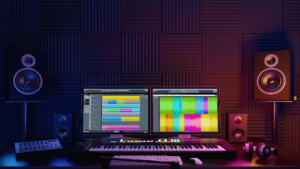
Every musician embarks on a journey of self-discovery to carve out their unique sound. Finding that distinct voice not only sets an artist apart but also enhances their music career by attracting a dedicated audience. Many struggle at first, influenced by mainstream trends or the sounds of their favorite artists, leading to a dilution of their true identity.
To uncover a unique sound, musicians should explore different genres, experiment with various instruments, and write from personal experiences. This exploration can spark creativity, allowing them to fuse influences into something truly original. Embracing authenticity and staying true to one’s artistic vision is vital in this process.
Moreover, collaboration with other artists can provide fresh perspectives and ideas, leading to unexpected innovations. Engaging with the music community aids in the evolution of their style, while continuous learning and self-reflection contribute to a more profound understanding of their musical identity.
Understanding Your Musical Identity
Discovering one’s musical identity involves a thorough exploration of influences and styles that resonate deeply. It is essential for musicians to connect with their unique voice while also nurturing their creativity. This process enhances the development of a distinctive sound that sets them apart.
Exploring Musical Influences
Musicians often draw inspiration from various genres and artists. Identifying favorite songs and understanding why they resonate can clarify personal tastes. Listening to different styles helps in recognizing elements that appeal to them, such as rhythm, melody, or lyrics.
Creating a list of key artists and tracks can provide insight into influences. For instance, a musician might admire a specific music producer for their innovative techniques or lyrical ability. This exploration assists in shaping individual preferences and can guide the direction of a musician’s work.
Developing Your Style of Music
Formulating a unique style requires combining different influences into something cohesive. Musicians should spend time experimenting with various genres to identify what resonates most. This exploration might lead to discovering a fusion of styles that feels authentic.
Engagement with other musicians can spur creativity. Collaborations enable individuals to push boundaries and explore new sounds. Recording sessions with music producers can also provide valuable feedback and encourage the development of a personal sound that stands out.
The Role of Creativity in Finding Your Sound
Creativity plays a crucial role in defining musical identity. Musicians should allow themselves the freedom to experiment without fear of judgment. Exploring unconventional arrangements or lyrical themes can lead to unexpected breakthroughs.
Keeping a journal or recording ideas regularly fosters a creative mindset. This practice may include experimenting with various instruments, writing lyrical drafts, or recording spontaneous melodies. Such activities can lead to the discovery of an original sound that feels true to the musician’s identity.
Practical Steps to Discover Your Sound
Finding a unique musical sound involves engaging in active listening, experimenting with sound design, understanding songwriting structures, and collaborating with others. The following steps provide a clear path to help musicians in this creative journey.
Active Listening and Analysis
Active listening is more than just hearing music; it is about deeply analyzing the elements that make up a track. Musicians should focus on various components like instrumentation, melodies, and harmonies. By identifying what resonates, they can draw inspiration from different genres.
Creating a list of favorite tracks and dissecting them can be beneficial. Ask questions: What makes a song appealing? What elements are unique? This analysis helps clarify personal preferences and informs future creative decisions.
Experimentation with Sound Design
Experimentation is key to discovering a unique sound. Musicians should approach sound design with curiosity. This can involve testing different instruments, effects, and production techniques. Using digital audio workstations (DAWs) provides diverse tools for creating textures and layers.
Setting specific challenges, like creating a track with only unconventional sounds, can push creative limits. Exploring unconventional scales or tunings can also lead to unexpected results. Embracing trial and error fosters innovation and personal expression.
The Importance of Songwriting and Structures
Songwriting is a critical aspect of a musician’s identity. Understanding various song structures—such as verse-chorus, AABA, or through-composed—enables the crafting of unique compositions. Musicians should analyze how their favorite songs are structured to identify what makes them compelling.
Incorporating unconventional song forms can help break the mold. Focus on melody and lyrics that align with personal experiences or emotions. This alignment creates authenticity and resonates more with audiences.
Collaboration and Feedback
Collaboration is essential for growth. Working with other musicians introduces new perspectives and ideas. It encourages creative discussion that can lead to innovative solutions in music composition.
Seeking feedback is equally important. Sharing work with peers allows for constructive criticism, which identifies areas for improvement. This process can refine one’s sound and lead to breakthroughs that may not occur in isolation. Forming connections within the music community enhances skill and fosters creativity.
Technical Aspects of Crafting Your Sound
Musicians can refine their unique sound through various technical methods. Attention to recording techniques, creative use of instrumentation, and genre blending plays a critical role in shaping an artist’s sonic identity.
Recording Techniques and Production Style
The recording environment significantly influences the final sound. Using high-quality microphones and preamps ensures clarity and depth. An artist can experiment with different recording techniques, such as room miking or close miking, to capture desired textures.
Layering tracks creatively enhances richness. This might involve stacking harmonies or utilizing stereo imaging to create a fuller sound. Attention to mixing and mastering techniques, like EQ and compression, is crucial for maintaining a cohesive sound across different platforms.
Exploring various production styles allows artists to discover what resonates with their vision. For instance, electronic music producers can blend analog synthesizers with digital plugins to achieve a unique sonic palette.
Using Unique Instrumentation and Sound Library
Incorporating unconventional instruments adds character and distinctiveness to music. Artists can explore options such as mandolins, theremins, or handmade instruments to diversify their sound.
Using a sound library can expand an artist’s creative horizons. Music production software offers a vast array of samples and virtual instruments. They can utilize these resources to discover new sounds and textures that stand apart from typical choices.
Experimenting with various timbres can lead to surprising results. It might be insightful to combine traditional instruments with electronic sounds, fostering a hybrid sound that captures listeners’ attention.
Merging Genres and Conventional Sounds
Blending genres can result in innovative music that defies categorization. By mixing elements from different styles, artists can create fresh sounds. For instance, merging rock and electronic music often leads to unique rhythms and melodies.
Identifying and incorporating unconventional sounds from various genres can yield exciting results. Artists should explore cultural influences, ensuring they are respectful and authentic in their approach.
This fusion not only creates uniqueness but also widens the audience reach. Audiences often appreciate hybrid genres, as they carry the familiar while introducing exciting novelties.
Consistency and Evolving Your Musical Voice
Developing a unique sound requires a balance between regular practice and allowing artistic evolution. Musicians benefit by honing their skills and staying true to their identity while also embracing growth.
Importance of Regular Practice
Regular practice is essential for any musician seeking to shape their unique sound. Committing to a consistent schedule builds technical proficiency and deepens understanding of one’s craft.
Aim to write a thousand songs; this quantity encourages risk-taking and experimentation.
With each piece, musicians refine their writing style and discover what resonates. Regularity also fosters a sense of discipline, allowing for breakthroughs in creativity that might not occur without dedication.
Staying True While Evolving
A musician’s unique sound should reflect their identity. Staying true to core influences while allowing for growth is crucial. This authenticity attracts an audience who connects with the artist’s genuine expression.
As they evolve, it’s important for musicians to maintain aspects of their style that define them. Keeping signature elements while exploring new genres or techniques can be an effective way to evolve.
This balance preserves their originality and enriches their musical journey.
Using Intuition to Guide Your Artistic Choices
Intuition plays a significant role in a musician’s artistic choices. Trusting instinct can lead to genuine moments in creation. Musicians should cultivate this inner voice to navigate their evolving sound.
Listening to one’s inner guidance often reveals unexplored avenues in songwriting. Instruments or techniques previously overlooked might suddenly inspire a fresh groove or melody.
Experimenting with these intuitive choices can produce a distinctive sound that feels natural and authentic. Embracing this process allows musicians to stay aligned with their artistic vision while adapting to their growth.










